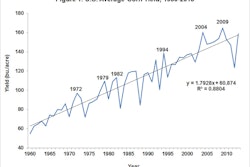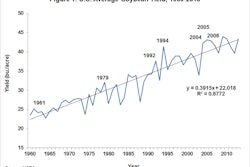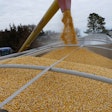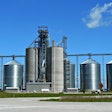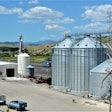The USDA will release its quarterlyGrain StocksandAcreagereports on June 30. These reports provide important fundamental information that will set the tone for the corn market going into the critical stage of the growing season. There is always opportunity for surprises in these reports and there is particular interest in the estimates this year given the $0.70 decline in corn prices over the past month.
股票的报告将提供一个估计的inventory of corn on June 1, revealing the pace of feed and residual use during the previous quarter and providing for a clearer expectation of the magnitude of stocks at the end of the 2013-14 marketing year. Given the difficulty of anticipating the magnitude of quarterly feed and residual use revealed in the report, it is useful to calculate the magnitude of the stocks estimate that would be considered neutral for prices. That calculation is based on the magnitude of use in other consumption categories during the March-May quarter, the USDA's forecast of feed and residual use for the year, and revealed feed and residual use use during the first half of the marketing year. Quarterly estimates of corn use in non-feed and residual categories (ethanol production, other processing uses, and exports) can be reasonably estimated based on monthly and weekly reports of use during the quarter. Based on monthly and weekly estimates from the U.S. Energy Information Administration, ethanol production during the March-May quarter this year exceeded that of last year by 7.8 percent. Assuming corn consumption increased by the same amount, corn use during the quarter should have totaled about 1.286 billion bushels. As a side note, to reach the projection for the entire year, ethanol production during the last quarter of the year needs to average about 37.84 million gallons per week. Production during the most recent 4-week period averaged about 39 million gallons per week. The production rate may slow somewhat due to some build-up of stocks, but it appears that ethanol production, and therefore corn consumption, will reach or slightly exceed the current forecast.
Estimates of corn consumption for other domestic processing uses are not readily available, but quarterly use is very consistent from year to year. Based on the USDA's projection of use for the year and use during the first half of the current year, use during the March-May quarter should have been near 375 million bushels.
Estimates of corn exports are available in weekly USDA reports and monthly Census Bureau reports. Census estimates become the official estimates in the USDA corn balance sheet, but are currently available only through April. Cumulative Census export estimates through April exceeded USDA estimates by 26 million bushels. Assuming that margin persisted through May, USDA export estimates suggest that exports for the March-May quarter totaled 619 million bushels, equal to the record exports for the quarter in 1981. To reach the USDA projection of 1.9 billion bushels for the year, exports will need to average 41 million bushels per week during the final quarter of the marketing year. The most recent 5-week average for corn export inspections was 43.9 million bushels.
For the year, the USDA projects feed and residual use of corn at 5.3 billion bushels. Use during the first half of the year, as revealed in the previous quarterly stocks reports, totaled 3.859 billion bushels. To reach the USDA projection, use during the last half of the year will need to total 1.441 billion bushels. Use will be larger in the third quarter and much smaller in the fourth quarter, although the portion of use during the two quarters has varied considerably. Use during the March-May quarter this year might have been near one billion bushels if use is tracking the USDA projection.
With March 1 stocks of 7.006 billion bushels, quarterly imports of about 6 million bushels, and quarterly consumption near 3.28 billion bushels, June 1 stocks would have totaled 3.732 billion bushels. An estimate near that level would be considered neutral for old crop corn prices. Recent history, however, suggests that the actual estimate could deviate enough from the expected level to generate a price response.
The USDA's MarchProspective Plantingsreport revealed U.S. producer intentions to plant 91.691 million acres of corn this year, 3.674 million fewer acres than planted in 2013. When that report was released, there was some speculation that corn acreage would exceed intentions based on what appeared to be an under-count of total crop acres in the report. A late planting season in northern growing areas and a late season increase in the ratio of soybean to corn prices, however, suggest that both soybean acreage and prevented plantings might exceed intentions in those areas, resulting in fewer corn acres than intended. While the June report of acreage will include intentions for unplanted acreage, the estimate of corn acreage should be near actual acreage to be revealed later in the year. Unless acreage deviates substantially from intentions, corn production expectations will continue to reflect weather conditions and yield expectations. Current corn crop conditions have the market expecting a U.S average yield at or above trend value.
Issued byDarrel Good
Department of Agricultural and Consumer Economics
University of Illinois







